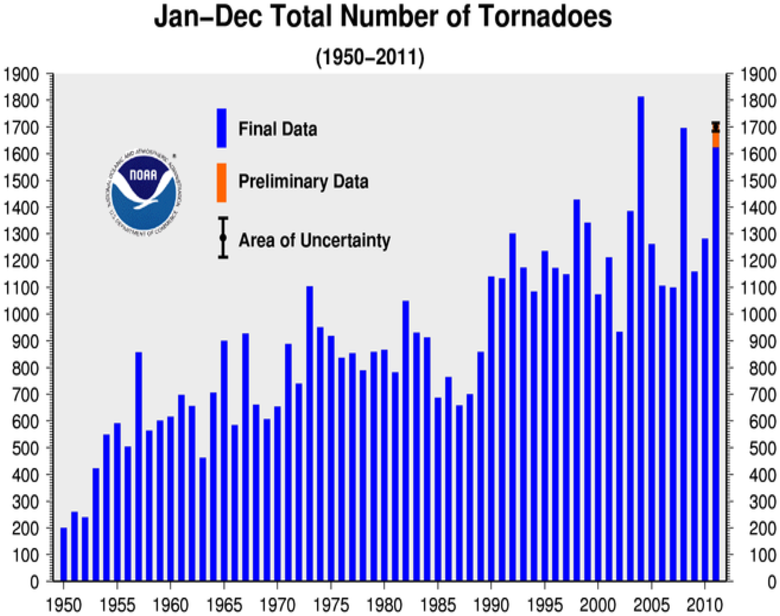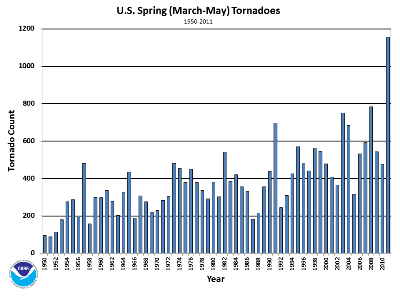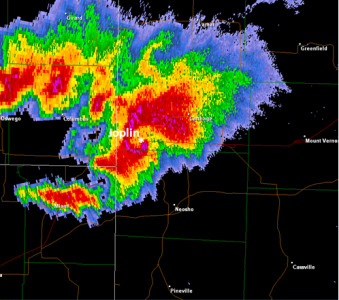Issued: 19 January 2012

2011 Tornado Occurrences
Source: SPC
The U.S. spring and summer of 2011 will likely be remembered as one of the most destructive and deadly tornado seasons to ever impact the nation. During the time period, there were seven individual tornado and severe weather outbreaks with damages exceeding one billion U.S. dollars, and total damage from the outbreaks exceeding 28 billion U.S. dollars. This represents the most property damage from severe weather in a single year since record keeping began in 1980. As of mid-January 2012, the 2011 confirmed tornado count stood at 1,625, with 93 tornado reports still pending for November and December. This places 2011 as the second or third most active year on record for number of tornadoes since the modern record began in 1950, depending on the confirmation rate of the end-of-year tornado reports. There were six EF-5 tornadoes confirmed during 2011, the strongest category on the Enhanced Fujita scale. This ties with 1974 as the most (E)F-5 tornadoes during a single year (Please note that NOAA switched form using the Fujita (F) scale to the Enhanced-Fujita (EF) scale in 2007). The annual total number of fatalities from tornadoes was 551, the most in the 62-year period of record.
Looking beyond the modern tornado record (1950-present), 2011 ties with 1936 as the second deadliest year for tornadoes in U.S. history. In 1925, 794 tornado-related fatalities were reported, the deadliest tornado year on record. The extensive damage and loss of life due to tornadoes during 2011 was a product of an above-average tornado year and strong tornadoes hitting densely-populated areas. During the year, the two largest tornado outbreaks on record for the nation impacted the southern U.S., and the single deadliest tornado since the modern record began in 1950 hit Joplin, Missouri.
The most active tornado period of the year was the spring season (March-May). During the three month period, there 1,150 confirmed tornadoes across the country, the most on record for any three month period. The most active month of the year was April, when 748 tornadoes were confirmed. This is the most on record for any month, surpassing May 2003 when there were 550 tornadoes. The extremely high tornado count during April was driven by two very large tornado outbreaks — the two largest tornado outbreaks on record. The tornado counts for the April 14th–16th and April 25th–28th outbreaks both surpassed the April 1974 Super Outbreak for number of tornadoes during a single outbreak. The 199 tornadoes on April 27th, was the most for any single day on record and the 316 fatalities on the same day was the most in the modern record for a 24-hour period. The May 22nd Joplin, Missouri tornado caused 3 billion dollars worth of damage and 158 fatalities, surpassing the previous records for damages and fatalities from a single tornado in the modern tornado record.
Significant Events
The April 14th–16th tornado outbreak was spawned from a strong upper-level low pressure system moving through the Central Plains. Very warm, moist air was advected northward ahead of the associated cold front. Behind the cold front, very cool Canadian air filtered into the central parts of the U.S., and the boundary between these two air masses was the trigger for the unprecedented tornado outbreak. Over the three days, 177 tornadoes occurred across 16 states (Oklahoma to North Carolina), surpassing the April 1974 outbreak as the most active tornado outbreak on record. The 30 tornadoes which were confirmed in North Carolina, where 22 of the fatalities were reported, was a state record. The damages from the outbreak will exceed 2.1 billion U.S. dollars, and there were 38 reported fatalities in all. The outbreak was the deadliest in the U.S. since 2008.
The April 25th–28th tornado outbreak occurred under similar circumstances as the April 14th–16th event, with a strong low pressure system moving through the center of the country. This was one of the largest, deadliest, and most destructive tornado outbreaks in the history of the United States. During the four days, there were 343 confirmed tornadoes which killed 321 people — both are records for a single outbreak. Alabama bore the brunt of the damage, where 240 people were killed, including 78 people from a single EF-5 in the northern portion of the state. Several metropolitan areas were directly impacted including Tuscaloosa, Birmingham, and Huntsville in Alabama and Chattanooga, Tennessee, causing the estimated damage costs to soar. Damages from the outbreak are expected to exceed 10.2 billion U.S. dollars.
The May 22nd Joplin, Missouri tornado was spawned from a severe thunderstorm moving from Kansas into Missouri during the late afternoon hours. The tornado was rated an EF-5 with winds in excess of 200 mph. The tornado was on the ground for 6 miles and had a maximum width of three-quarter miles as it moved through the densely populated southern portion of the town. The tornado killed 158 people and injured thousands more, making it the deadliest tornado in the 1950-present modern tornado record. Damages from this single tornado are expected to exceed 3 billion U.S. dollars, the most on record for a single tornado in U.S. history.
Additional information is available in the Spring 2011 Climate Extremes Special Report and the monthly tornado summaries.
 NOAA's National Centers for Environmental Information
NOAA's National Centers for Environmental Information





